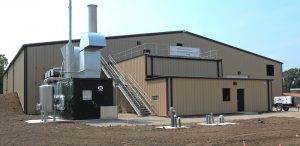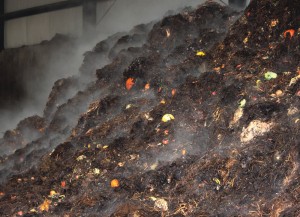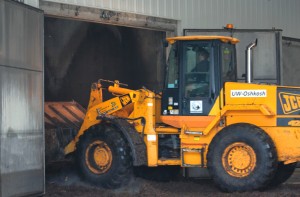To help achieve its goal of energy independence, the University of Wisconsin in Oshkosh invested in a high solids, dry fermentation anaerobic digester to process source separated organics.
Nora Goldstein
BioCycle February 2012, Vol. 53, No. 2, p. 35

An 18,000 sq. ft. building houses the fermenters, mixing area, digestate storage, percolate tank and biogas collection and storage. The CHP unit is in the foreground on the left.
The university learned about the potential of generating energy via anaerobic digestion in late 2006 while attending an ACORE (American Council on Renewable Energy) Conference. Pursuit of the idea to install a biodigester continued throughout 2007, and in mid-2008, a delegation from UWO traveled to Germany to tour operating facilities. By this time, the university had zeroed in on the BIOFerm dry fermentation technology. “Originally, we were looking at only digestion of food waste, but then we met a representative from BIOFerm, who introduced us to the concept of processing additional feedstocks with the food waste, which led us to deciding on the dry fermentation system,” recalls Sonnleitner. “We received technical and financial assistance from Wisconsin’s Focus on Energy to proceed with the project.” UWO opted to build, own and operate the facility. The plant was designed and constructed by BIOFerm Energy Systems, based in Madison, Wisconsin.
Design began for a 8,000 tons/year dry fermentation plant to process separated food waste from the dining halls, commercial organics from area generators such as grocery stores, yard trimmings and silage and other farm biowaste. The plant was sited on university property adjacent to the city of Oshkosh’s wastewater treatment plant (and across the street from the municipal yard trimmings composting site). The university wrote a business plan to guide project development and help raise capital for the $4.7 million facility (includes all equipment, land and soil remediation). Grant funding for the biodgester came from the state of Wisconsin ($232,587), the U.S. Department of Energy ($500,000) and U.S. Treasury Section 1603 ($1.0 million) through the federal stimulus package. “We were strongly supported by the UW Oshkosh Foundation,” says Sonnleitner.
Construction of the biodigester was completed in July 2011 and commissioning began in August. The facility has four fermenters, each 70-ft long by 23-ft wide by 16.5ft high (volume of about 27,000 ft3). An 18,000 sq. ft. building houses the fermenters, mixing area, digestate storage, percolate tank and biogas collection and storage. A 370 kW combined heat and power (CHP) unit was supplied by 2G Energy. Installed on a skid, it uses a MAN engine block.) The unit has the capacity to generate 3.07 million kWh annually, however the complete system is expected to generate 2.3 million kWh annually. The 7,900 MMbtu of thermal energy eventually will be used to heat adjacent buildings.
Start-up of the plant began in mid-August. The facility has a solid waste permit from the Wisconsin Department of Natural Resources. Separated manure solids, combined with straw and food waste, were used as the starting materials. The CHP unit began operating the first week of October 2011. Electricity is purchased by Wisconsin Public Service for an average (of peak and off peak rates) of 8.8 cents/kWh. The utility receives the carbon credits.
Final transfer of plant operations from BIOFerm to UWO will happen in the spring of 2012. “We aren’t 100 percent turned over yet,” noted Brian Langolf, UWO’s plant manager, in early January. “We are at about 90 percent as BIOFerm is still doing some work on optimizing the computer software.”
Plant Operations
Currently, the UWO biodigester is operating at about 55 percent of its capacity. It is receiving 40 to 60 tons/week of food waste from grocery stores and restaurants, collected and delivered by Sanimax. Some food processing residuals also are received. No tipping fee is being charged at this time, in order to procure an adequate quantity of feedstocks for plant operations. “We’ve wanted to ensure that we have enough material for plant optimization and biogas generation,” says Langolf. “We are just getting into the phase of understanding what mixes give the best optimization. We can easily double the quantity of food waste we are receiving now.”
Feedstocks currently being digested are food waste, yard trimmings and crop residues and livestock bedding. “It’s roughly 15 to 20 percent food waste and 40 percent or less bedding, with the remainder comprised of recycled digestate to inoculate the new material,” explains Langolf. “Yard trimmings average 5 to 10 percent of the mix, but there is less at this time of year.”
The system is designed to have upwards of 25 to 35 percent solids content in the starting mix. Incoming materials are unloaded on the tipping floor. A front-end loader is used to crush any large size items (pumpkins were evident when BioCycle toured the plant in late October), as well as blend feedstocks prior to loading the fermenters. Retention time in the units is currently 28 days. Start up of each fermenter was staggered; all four have been fully in use since September.
The facility has a 120,000-gallon percolate tank that is kept at a steady temperature using waste heat from the CHP. The percolate is liquid that is continually recirculated through the fermenters and contains requisite anaerobic microorganisms for methane production. Once a fermenter is filled, percolate is intermittently added via spray nozzles at the top of the digester, which gravity drains through the digesting material.
Biogas generated by the fermenters and percolate tank is captured and stored in a flexible, pillow shaped gas storage bag, constructed of the same material as typical wet digester roof domes. It is installed on the second level of the plant above the fermenters. The bag has enough capacity to allow for up to two to six hours of CHP downtime. Beyond that time, biogas is directed to a flare.
At the end of the 28-day retention time, a shut down sequence begins prior to unloading the fermenter. Percolate stops being added several days prior to unloading, so free liquid can drain from the material. Four to six hours prior to opening the fermenter, there are 10 air changes/hour, with all methane blown off in about three hours. That purge gas, a low quality biogas, is currently discharged over the roof, however the system is being redesigned to run this gas into the CHP. The plant software utilizes an automated gas quality measurement system to regularly check the gas quality in each fermenter, the percolate tank and the gas bag to make certain system decisions and/or allow the operator to open the fermenter doors.
Mixing area ventilation and fermenter exchange exhaust air are treated through a 12-ft high by 12-ft wide by 60-ft long biofilter located outside the main building. The media is comprised of 5-feet of lava rock.
After unloading, digestate is moved to a storage bunker. Material that isn’t retained for mixing with new feedstocks is taken on a back-haul by a farmer who land applies it (the farmer delivers livestock bedding to the plant), or goes to Zillges Materials, Inc. in Oshkosh for composting. Zillges just started receiving digestate this winter. “We expect to get about 2,000 cubic yards/year,” says Tim Zillges. His company, which sells landscape supplies, spas, outdoor furniture and other products, composts about 2,500 cy/year of yard trimmings. “We’ve built several windrows with the digestate, mixing it with either yard trimmings or horse manure,” he adds. “The material is pretty wet, so we are experimenting with the recipes.”
Zillges had to repermit the composting facility in order to take the digestate and animal waste. The company recently purchased a windrow turner from Midwest Bio-Systems. It already owns a McCloskey trommel, which is utilized for its topsoil operation. “We are excited about being involved with the University’s biodigester facility,” notes Zillges. “We are still on a learning curve.”

Feedstocks currently being digested are food waste, yard trimmings, crop residues and livestock bedding.
Biogas Utilization
The CHP unit was sized for more than the quantity of biogas produced by the biodigester, as UWO formed a partnership with the neighboring wastewater treatment plant to receive its biogas, which is only utilized by the WWTP during the winter. “The UWO biodigester is currently producing 165 kW, and we think we can get that up to 225 to 230 kW when operations are optimized,” says Drew Tuchscherer with BIOFerm. “The remaining capacity of the 370 kW genset will be utilized by the WWTP’s biogas.”
The standard BIOFerm automated desulfurization system removes hydrogen sulfide. The system meters oxygen into the fermenters to scrub the H2S. An activated carbon filter was installed to scrub siloxane and H2S from the WWTP biogas. “We are getting H2S levels down to 0 to 10 ppm with the filter,” adds Tuchscherer.
Concurrent with development of the biodigester, UWO has invested $700,000 in renovation of a laboratory that will have full service analytical capabilities and on-site testing. The lab will be able to do methane evolution determinations, methanogen selection and optimization and air, water and solid matrix testing. It will also house bench-scale and pilot-scale bioreactors. “As the operator of a digester, we want to maximize biogas generation in order to maximize the payback of the facility,” says Gregory Kleinheinz, an Associate Dean at UWO.
Langolf, a microbiologist by training, also is overseeing work in the laboratory related to the biodigester. “Right now, we are mostly doing basic testing of ongoing operations of the biodigester, tracking daily, weekly and monthly parameters to monitor plant performance,” he says. “Next we will be focusing on how to increase biogas production, looking at the microecology of the digester, testing a variety of feedstocks and doing microbial and chemical analyses.” UWO students work both in the laboratory and at the biodigester, conducting research and in some cases, helping out with operations.
The university is also proceeding with a second digester, this one to be located at a dairy about 15 miles from the main campus. Groundbreaking for the wet digester is scheduled for spring of 2012, with a projected start up in 2013. The facility will be owned by the UW Oshkosh Foundation and led, managed and operated by UWO faculty, students and staff. A remote classroom and laboratory will be constructed. “The new facility will help UW Oshkosh continue to redirect financial resources previously spent on campus energy bills to the expansion of academic programs and classroom seats,” explains Sonnleitner. “That is the core of our institution’s mission.”











